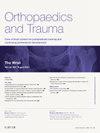At the peak: a review of current diagnostic and therapeutic concepts surrounding tibial plateau fractures
Q4 Medicine
引用次数: 0
Abstract
Tibial plateau fractures are complex injuries commonly resulting from high-energy trauma in younger patients or low-energy falls in the elderly. They significantly impair knee function and overall quality of life, often leading to complications such as post-traumatic osteoarthritis and knee stiffness. This review looks at current diagnostic modalities, epidemiological data, anatomical considerations, and therapeutic strategies for managing tibial plateau fractures, highlighting advancements in treatment and outcomes. The well-established Schatzker and AO/OTA systems of classification have evolved alongside emerging frameworks like the three-column classification and ten-segment concepts that utilize three-dimensional imaging technologies. Tibial plateau fractures have an estimated incidence of 10.3 per 100,000 people, with males affected more frequently than females. The incidence increases with age, particularly among women in their seventh decade. The management of tibial plateau fractures can involve either non-operative or operative interventions. While minimally displaced fractures may be treated conservatively, more complex cases typically require surgical procedures such as open reduction and internal fixation or arthroscopically assisted techniques. Recent improvements in rehabilitation protocols and surgical techniques aim to enhance recovery and minimize complications. Long-term assessments indicate that functional deficits and complications persist in many patients following tibial plateau fractures. Factors such as age, fracture type, and soft tissue integrity significantly influence recovery trajectories. Effective management of tibial plateau fractures requires a multi-faceted approach that utilizes imaging techniques, judicious surgical intervention, and patient-tailored rehabilitation. Further research is needed to refine treatment protocols and establish standardized methods for evaluating functional outcomes.
在高峰:当前诊断和治疗概念的回顾胫骨平台骨折
胫骨平台骨折是一种复杂的损伤,通常由年轻患者的高能创伤或老年人的低能跌倒引起。它们严重损害膝关节功能和整体生活质量,经常导致创伤后骨关节炎和膝关节僵硬等并发症。这篇综述着眼于目前治疗胫骨平台骨折的诊断方式、流行病学数据、解剖学考虑和治疗策略,强调了治疗和结果的进展。成熟的Schatzker和AO/OTA分类系统与新兴的框架一起发展,如利用三维成像技术的三列分类和十段概念。胫骨平台骨折的发生率估计为每10万人10.3例,男性比女性更常见。发病率随着年龄的增长而增加,特别是在70多岁的妇女中。胫骨平台骨折的治疗包括非手术治疗和手术治疗。虽然微创移位骨折可以保守治疗,但更复杂的病例通常需要外科手术,如切开复位和内固定或关节镜辅助技术。最近在康复方案和手术技术方面的改进旨在提高康复和减少并发症。长期评估表明,许多胫骨平台骨折患者的功能缺陷和并发症持续存在。年龄、骨折类型和软组织完整性等因素显著影响恢复轨迹。胫骨平台骨折的有效治疗需要多方面的方法,包括影像学技术、明智的手术干预和患者量身定制的康复治疗。需要进一步的研究来完善治疗方案和建立评估功能结果的标准化方法。
本文章由计算机程序翻译,如有差异,请以英文原文为准。
求助全文
约1分钟内获得全文
求助全文
来源期刊

Orthopaedics and Trauma
Medicine-Orthopedics and Sports Medicine
CiteScore
1.00
自引率
0.00%
发文量
57
期刊介绍:
Orthopaedics and Trauma presents a unique collection of International review articles summarizing the current state of knowledge and research in orthopaedics. Each issue focuses on a specific topic, discussed in depth in a mini-symposium; other articles cover the areas of basic science, medicine, children/adults, trauma, imaging and historical review. There is also an annotation, self-assessment questions and a second opinion section. In this way the entire postgraduate syllabus will be covered in a 4-year cycle.
 求助内容:
求助内容: 应助结果提醒方式:
应助结果提醒方式:


